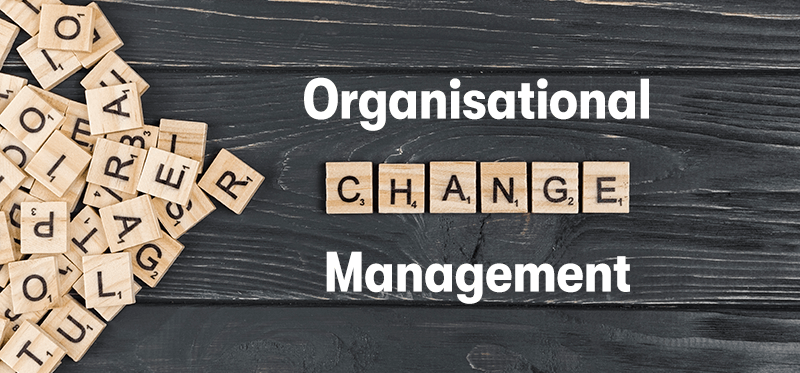ITIL is a widely recognised framework for IT service management. It provides guidelines and best practices for aligning IT services with the needs of the business. Organisational Change Management (OCM) is an essential component of ITIL that focuses on managing the human side of change within an organisation.
ITIL® Organisational Change Management
OCM in ITIL involves planning, executing, and monitoring the changes that occur during the implementation of IT services. It aims to minimise resistance and maximise adoption of new processes, technologies, or organisational structures. It should not be confused with the Change Enablement practice which focuses mainly on day-to-day technical change.
What is ITIL Organisational Change Management?
Here are some key aspects of ITIL Organisational Change Management:
Change Strategy
OCM starts with developing a comprehensive change strategy that aligns with the organisation's goals and objectives. It involves identifying the scope and impact of the change, understanding the stakeholders, and establishing the desired outcomes.
Change Planning
This phase involves creating a detailed plan for managing the change. It includes defining roles and responsibilities, establishing communication channels, and outlining the timeline and milestones. The plan should consider potential risks and mitigation strategies.
Communication and Stakeholder Engagement
Effective communication is crucial during a change initiative. OCM emphasises engaging and involving stakeholders throughout the process. Clear and timely communication helps manage expectations, address concerns, and gain support for the changes.
Training and Education
OCM recognises the importance of providing adequate training and education to employees to enable them to adapt to the changes. Training programs should be designed to equip individuals with the necessary skills and knowledge to perform their roles effectively in the new environment.
Resistance Management
Resistance to change is natural within organisations. OCM focuses on identifying and addressing sources of resistance. It involves addressing concerns, providing support and guidance, and highlighting the benefits of the changes to overcome resistance and encourage acceptance.
Measurement and Evaluation
OCM emphasises measuring and evaluating the success of change initiatives. Key performance indicators (KPIs) are defined to assess the effectiveness of the changes. Feedback mechanisms, such as surveys or focus groups, can be used to gather insights and identify areas for improvement.
Continuous Improvement
OCM is an iterative process that emphasises continuous improvement. Lessons learned from previous changes are applied to future initiatives, and feedback is used to refine and enhance the change management approach.
By incorporating OCM principles into ITIL, organisations can better manage the impact of changes on their employees, enhance adoption rates, and ultimately achieve successful outcomes from IT service management initiatives.
What is the Objective of Organisational Change Management?
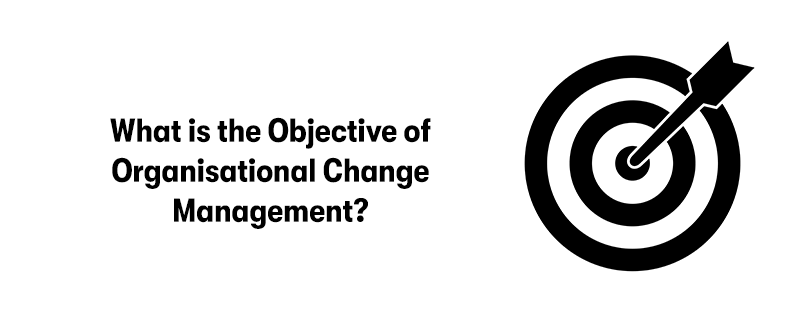
The objective of ITIL Organisational Change Management is to facilitate and manage the human side of change within an organisation during the implementation of IT services. The primary goals of ITIL OCM include:
Minimising Resistance
OCM aims to reduce resistance to change by addressing concerns, fears, and uncertainties that individuals may have when faced with changes in processes, technologies, or organisational structures. By understanding and addressing resistance, OCM helps create a more positive and accepting environment for the changes.
Maximising Adoption
OCM focuses on ensuring the successful adoption of new processes, technologies, or services by employees. It aims to encourage and support individuals in embracing the changes and utilising them effectively in their work. By promoting adoption, OCM helps organisations realise the expected benefits and value from the implemented changes.
Managing Risks
OCM plays a critical role in identifying, assessing, and managing risks associated with change initiatives. It helps anticipate potential challenges, such as disruptions in productivity or employee morale, and develops strategies to mitigate these risks. By proactively managing risks, OCM minimises the negative impact of changes on the organisation.
Enhancing Communication
Effective communication is a key objective of OCM. It focuses on ensuring that information regarding the changes is communicated clearly, consistently, and in a timely manner to all stakeholders. By improving communication, OCM helps to manage expectations, address concerns, and build support for the changes throughout the organisation.
Supporting Employees
OCM recognises the importance of supporting employees throughout the change process. It aims to provide the necessary training, resources, and support mechanisms to help individuals adapt to the changes and perform their roles effectively. By offering support, OCM reduces the potential for disruption and enhances employee satisfaction and productivity.
Ensuring Continuous Improvement
OCM promotes a culture of continuous improvement by gathering feedback, evaluating the effectiveness of change initiatives, and applying lessons learned to future changes. It aims to refine and enhance the change management processes and strategies based on the organisation's experiences. By fostering continuous improvement, OCM helps organisations adapt to evolving needs and challenges.
Overall, the objective of ITIL Organisational Change Management is to facilitate a smooth and successful transition during the implementation of IT services, ensuring that changes are embraced, risks are managed, and the organisation can effectively realise the benefits and value of the changes.
Why is Organisational Change Management Important in ITIL?
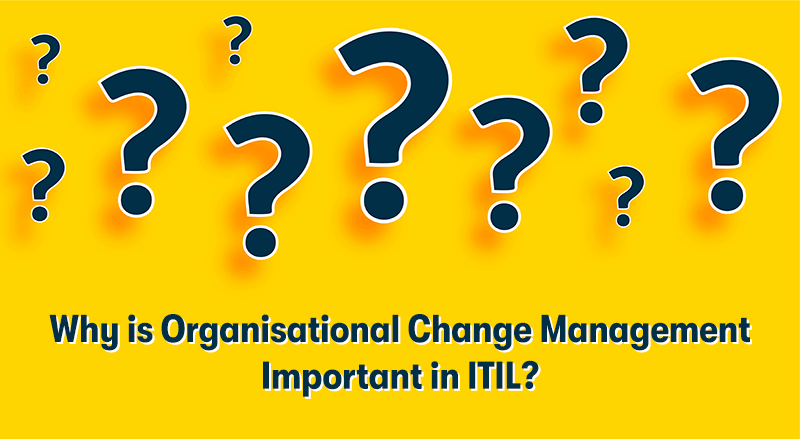
Organisational Change Management is essential in ITIL for several reasons:
Maximising Adoption and Benefits
ITIL initiatives often involve significant changes in processes, technologies, and organisational structures. OCM helps ensure that these changes are effectively adopted and embraced by employees. By managing the human side of change, OCM increases the likelihood of successful implementation and maximises the realisation of anticipated benefits.
Minimising Resistance
Resistance to change is a common challenge in organisations. OCM recognises this and addresses it proactively. By understanding and addressing the concerns, fears, and uncertainties associated with change, OCM helps reduce resistance and increases acceptance and cooperation from employees.
Enhancing Employee Engagement
OCM focuses on engaging employees throughout the change process. By involving employees in the decision-making, planning, and implementation stages, OCM helps foster a sense of ownership and commitment. Engaged employees are more likely to support and actively contribute to the changes, leading to better outcomes.
Managing Risks
Change initiatives can introduce risks and disruptions. OCM identifies potential risks, assesses their impact, and develops strategies to mitigate them. By managing risks effectively, OCM minimises the negative consequences of change, such as productivity losses, employee dissatisfaction, or resistance, and ensures a smoother transition.
Improving Communication
Clear and effective communication is crucial during change initiatives. OCM emphasises open and transparent communication channels to keep stakeholders informed about the changes, their impact, and the benefits they bring. By improving communication, OCM helps manage expectations, address concerns, and build trust and support for the changes.
Supporting Skill Development
ITIL often introduces new processes and technologies that require employees to acquire new skills and knowledge. OCM includes training and education initiatives to support employees in developing the competencies needed to work effectively in the new environment. By providing the necessary support, OCM reduces the learning curve and helps employees adapt to the changes more efficiently.
Ensuring Continuous Improvement
OCM promotes a culture of continuous improvement by gathering feedback, evaluating the effectiveness of change initiatives, and incorporating lessons learned into future changes. This iterative approach helps organisations refine their change management processes and strategies, resulting in better outcomes and a more adaptable and resilient organisation.
In summary, OCM is crucial in ITIL because it ensures that changes are effectively implemented and adopted, minimises resistance and risks, enhances employee engagement, and promotes continuous improvement. By focusing on the human side of change, OCM increases the likelihood of successful ITIL initiatives and the organisation's ability to adapt to evolving needs and challenges.
What is Important to Understand About ITIL Organisational Change Management?
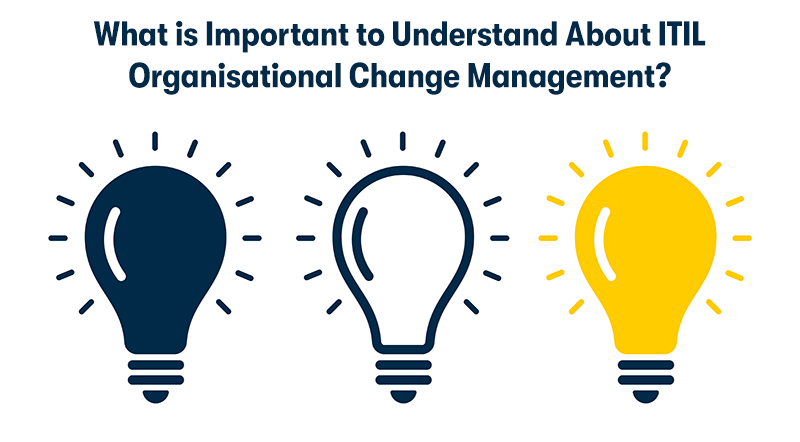
When it comes to understanding ITIL Organisational Change Management, there are a few key points that are important to grasp:
Integrated Approach
OCM in ITIL is not a standalone process but rather an integral part of the overall IT service management framework. It should be integrated into the entire ITIL lifecycle, including the stages of service strategy, service design, service transition, service operation, and continual service improvement. This ensures that change management activities are aligned with the organisation's overall goals and objectives.
People-Centric Focus
OCM recognises that successful change management is primarily about managing the people side of change. It emphasises understanding the impact of change on individuals, teams, and the organisation as a whole. This includes addressing concerns, providing support, facilitating communication, and promoting employee engagement to encourage acceptance and adoption of the changes.
Leadership and Sponsorship
Strong leadership and active sponsorship from senior management are crucial for successful OCM. Leaders play a vital role in communicating the importance of the changes, setting the direction, and driving the change initiative. They should demonstrate commitment, provide resources, and actively participate in change management activities.
Communication and Engagement
Effective communication is a fundamental aspect of OCM. It is important to communicate the rationale for the changes, the expected benefits, and the impact on individuals and the organisation. Communication should be timely, transparent, and tailored to different stakeholder groups. Engaging stakeholders throughout the change process builds trust, manages expectations, and garners support.
Change Readiness and Impact Assessment
OCM involves assessing the organisation's readiness for change and understanding the potential impact of changes on different aspects of the organisation. This includes evaluating the organisation's culture, capacity for change, and the readiness of employees to embrace and adopt new ways of working. Impact assessments help identify potential risks, dependencies, and areas that require special attention during the change process.
Training and Education
Providing the necessary training and education to employees is crucial for successful change adoption. OCM emphasises developing and delivering training programs to equip individuals with the knowledge, skills, and capabilities required to adapt to the changes. Training should be relevant, accessible, and aligned with the specific needs of different roles and functions within the organisation.
Continuous Improvement
OCM is an iterative process that emphasises learning and continuous improvement. It involves gathering feedback, measuring the effectiveness of change initiatives, and incorporating lessons learned into future changes. This ensures that change management practices evolve and mature over time, leading to more effective and efficient change implementation.
By understanding these key aspects, you can better grasp the importance of ITIL Organisational Change Management and how it contributes to successful change initiatives within an organisation.
What is The Organisational Change Management Lifecycle
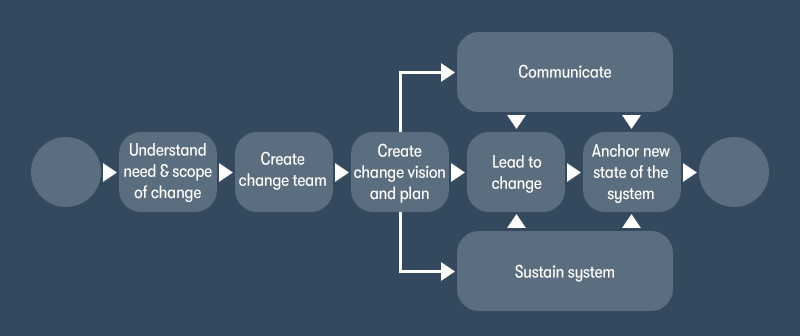
Understanding the need and scope of change
Assessment: Evaluate the current state of the organisation to identify areas needing improvement.
Identify Objectives: Clearly define what needs to be changed and why. This involves understanding the business objectives, customer needs, and market trends.
Stakeholder Analysis: Identify who will be affected by the change and understand their perspectives and concerns.
Scope Definition: Clearly delineate the boundaries of the change, including what will and will not be included.
Create change team
Team Formation: Select a diverse group of individuals with the necessary skills and authority to drive the change.
Roles and Responsibilities: Define clear roles and responsibilities for each team member, ensuring a balance of skills and perspectives.
Team Dynamics: Develop a team culture that encourages open communication, collaboration, and problem-solving.
Training and Support: Provide the change team with the necessary training and resources to effectively manage the change process.
Create change vision and plan
Vision Statement: Develop a clear and compelling vision for the future state of the organisation.
Strategic Planning: Outline the strategy and steps required to achieve the vision.
Milestones and Metrics: Establish key milestones and performance metrics to track progress.
Risk Management: Identify potential risks and develop mitigation strategies.
Lead to change
Leadership Engagement: Ensure leaders at all levels are committed to the change and are actively leading by example.
Empowerment: Empower employees to contribute to the change process and make decisions.
Quick Wins: Identify and achieve quick wins to build momentum and demonstrate the benefits of the change.
Resilience Building: Support and build resilience among employees to manage the challenges of change.
Anchor new state of the system
Integration: Fully integrate the new processes, systems, and behaviours into the organisation.
Reinforcement: Continually reinforce the new state through policies, procedures, and cultural norms.
Feedback Loops: Establish mechanisms for ongoing feedback to ensure the new state is functioning effectively.
Adaptation: Be prepared to make adjustments as needed based on feedback and changing conditions.
Sustain system
Continuous Improvement: Encourage a culture of continuous improvement where feedback is used to make ongoing enhancements.
Long-term Planning: Align change initiatives with long-term strategic planning.
Performance Monitoring: Regularly monitor performance against established metrics to ensure sustained success.
Change Advocacy: Develop change advocates within the organisation who can support and promote the new state.
Communicate change
Communication Strategy: Develop a comprehensive communication plan that addresses the needs and concerns of all stakeholders.
Consistent Messaging: Ensure consistent and clear messaging throughout the organisation.
Engagement Activities: Use a variety of channels and activities to engage employees and stakeholders.
Feedback Mechanisms: Establish channels for two-way communication to gather feedback and address concerns.
Organisational Change Management Roles and Responsibilities

Organisational Change Management involves various roles and responsibilities that are crucial for effective change implementation. The specific roles may vary depending on the organisation and the scope of the change initiative, but here are some common roles and their associated responsibilities in OCM:
Change Sponsor/Executive Sponsor:
The change sponsor or executive sponsor is responsible for providing overall leadership and sponsorship for the change initiative. They define the vision, goals, and desired outcomes of the change. They allocate necessary resources and support for the change and communicate the importance of the change to the organisation.
Change Manager:
The change manager plays a crucial role in developing and executing the change management strategy and plan. They coordinate and facilitate change management activities, identify and assess risks, and develop mitigation strategies. The change manager also monitors and reports on the progress of the change initiative and engages and communicates with stakeholders throughout the process.
Change Agents/Change Champions:
Change agents or change champions serve as advocates for the change within their respective areas or departments. They help communicate the benefits and rationale for the change to colleagues and provide support and guidance to employees during the change process. They address concerns, questions, and resistance to the change and act as a liaison between employees and the change management team.
Communication Specialist:
The communication specialist is responsible for developing and executing the communication plan for the change initiative. They create clear and compelling messages about the change, identify appropriate communication channels and tools, and deliver timely and relevant information to stakeholders. The communication specialist also monitors and evaluates the effectiveness of communication efforts.
Training and Development Specialist:
The training and development specialist assesses the training needs of employees related to the change. They develop and deliver training programs and materials, provide support and guidance to employees during training, and evaluate the effectiveness of training interventions. They also address knowledge gaps and provide ongoing learning opportunities.
HR Business Partners:
HR business partners collaborate with the change management team to align change initiatives with HR practices. They identify potential impacts of the change on employees and HR processes, assist in addressing employee concerns, and manage employee transitions. HR business partners also support talent management activities related to the change, such as workforce planning and skills assessment.
Project Managers:
Project managers collaborate with the change management team to align change activities with project plans. They coordinate and integrate change management activities into the overall project timeline, monitor and report on change-related project risks and issues, and ensure that change management activities are integrated with other project activities.
These roles and responsibilities work together to ensure that the change initiative is well-planned, effectively communicated, and supported throughout the organisation. Collaboration and coordination among these roles are key to successful organisational change management.
Final Notes on Organisational Change Management for ITIL
As we conclude this discussion, remember that change is a constant in today's dynamic business environment. By embracing the principles of ITIL OCM and valuing the importance of clear communication, leadership support, and employee engagement, organisations can create a culture that thrives on change, adapts to new challenges, and achieves desired outcomes.
So, let's embrace organisational change management as a powerful tool for driving successful change initiatives. By prioritising the human aspect of change, organisations can unlock their full potential, drive innovation, and create a resilient and agile future.
In this ever-evolving landscape, change becomes an opportunity for growth and transformation. Let's embark on this journey together, equipped with the knowledge and understanding of ITIL OCM, and embrace the possibilities that change can bring to our organisations and the people within them.


